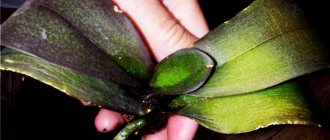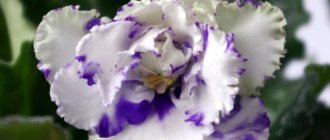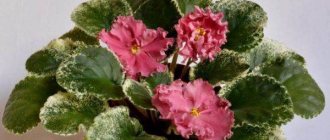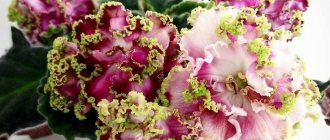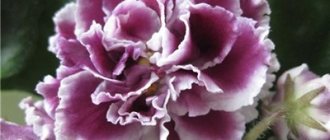The African violet first appeared in the 90s of the nineteenth century. More precisely in 1893 at a flower exhibition. In the article you will see a photo and description of the variety that will be discussed.
are especially popular among gardeners
- Their appearance at a flower exhibition back in 1893 was just a significant event for these flowers. The presented specimens of flowers grown from seeds attracted everyone's attention;
- Saintpaulia (Sauntpolia ionanta) Saintpaulia violetflower or Saintpaulia violetflower grows undetected in natural conditions in the Uzambara Mountains of East Africa . Named after the Saint Paul family. They are also called African violets;
- Already in the twenties, their industrial cultivation began . And to the 20 species in nature, thousands of hybrids were added. Which are now on our window sills and balconies;
- Since the fifties, the Leningrad botanists and spouses Makuni have been researching, growing and popularizing them in the Soviet Union.
And since the eighties and nineties - many enthusiastic flower growers. Among them:
- Aksenkina O.N.;
- Korshunova E.N.;
- Lyubetskaya E.N.;
- Morev K.L.;
- Repkina S.N.
Growing
For luxurious flowering and the formation of a beautiful violet rosette, it is enough to choose the right pot and suitable soil, adjust the watering and add fertilizers as necessary. Humidity levels and temperature are a minor influence, although Blue Dragon does best in moderate cool conditions. High temperatures can deprive a plant of its aesthetic appearance: flowers become smaller, petioles take on an unnaturally elongated shape, and leaves become brown in color.
Priming
It is advisable to mix nutritious soil for Saintpaulia yourself. You will need:
- leaf soil;
- river sand;
- peat;
- charcoal.
You can buy a ready-made mixture suitable for violets at a specialty store. The soil must be kept moist and loosened. In this case, the substrate may be heterogeneous in composition depending on the method of watering preferred by the grower. Top watering involves 2 parts of high-moor peat and 2 parts of perlite, or their ratio is 3X1. For wick irrigation, mix peat with perlite in a 1X1 ratio.
To prevent fungal diseases and prevent the occurrence of mold on the soil, it is better to add crushed activated carbon or sphagnum moss, which is a natural antiseptic, to the soil.
Pot
Violet is comfortable growing in a low container, since it has a shallow, extensive root system. The diameter of the pot for planting should be less than 5 cm for young violets, 2 cm more after the appearance of young leaves and up to 9 cm for mature plants. The smallest representatives of the “Blue Dragon” are planted in containers up to 4 cm in diameter. Be sure to make drainage holes at the bottom of the pot so that excess water is drained into the pan. Otherwise, the roots of the violet will soon rot and the flower will die.
Lighting
Setting buds is possible only with sufficient lighting. The violet needs 10–14 hours of daylight, so in winter it will need additional lighting. Fluorescent or LED lamps are suitable for its organization. Flower growers and violet collectors use the second, more practical option. In addition, LEDs increase the temperature around the plants.
For growing Blue Dragon on a windowsill, the western or eastern side is more suitable. The sun on the south side in the summer heat can cause burns on the surface of the leaves. If it is impossible to move the flower to a more suitable place, you should try to shade it. To do this, a reflective film is glued to the glass, or, in extreme cases, plain paper or newspaper.
Temperature and humidity
The optimal temperature for the Blue Dragon violet is +18–+ 24°C. In the winter season it should not be below 10°C. You also need to protect the plant from drafts
For lush flowering, it is important to maintain moderate humidity. Dryness in the air is a reason to place the pot on a tray with moistened pebbles or peat
You should also carefully spray the violet with water, making sure that no drops get on the leaves.
This is interesting: Ficus benjamina is shedding leaves - what to do, how to save
Variety history and description
The Dragon Blue violet is the creation of American breeder Lyndon Lyon. The variety is named after the eastern dragon, a symbol of wisdom, power and blessed life-giving rain. In 2005, Lyndon Lyon for the first time succeeded in breeding terry violets, and later star varieties with flowers in blue shades of complex tonality. Before this, only purple flowers existed in nature. “Blue Dragon” is also distinguished from other violets by its large, star-shaped flowers (8–9 cm).
What is unusual about this variety is the framing of large, strong flowers with a golden-green border. But a contrasting edging appears only in cool weather. In hot weather it may not be there at all.
Hot air causes pale spots to appear on flowers. At the next flowering, the appearance of the petals returns to normal.
Proper care of the plant guarantees abundant flowering. Reviews from some gardeners say that one bush of this variety produces up to 50 beautiful flowers with a red-violet double edging. Each peduncle bears an inflorescence up to 7 cm in size, consisting of 3–5 flowers. Their shade ranges from deep blue to deep purple or blue.
The violet has a peculiarity: after the buds with a dark blue center appear, the leaves may curl a little. This is considered the norm. As soon as the flowers appear, they become even again. The leaves are dark green in color, with a reddish tint on the reverse side. The leaf blades are arranged horizontally and have light serrations on their edges.
The plant develops a large rosette. In some cases, it reaches 45 cm. Space is important for this variety of violets: neighboring pots on the windowsill should not be crowded, otherwise the capricious flower will begin to lift or even shed its leaves.
If the plant is located on a windowsill, the foliage should not be pressed against the glass. The “Blue Dragon” is not characterized by rapid growth, and sometimes even “falls asleep”, as if suspending development.
Violets for the newbie!
Uzambara (Uzumbar) violet is a plant of the Gesneriaceae family, growing in the natural environment of tropical and subtropical regions of Asia, Africa, Eastern Australia, South America and the Indian Ocean islands.
Saintpaulia is a plant named after the Saint-Paul father and son, who brought a plant unknown to Europeans from the Uzambara district (modern Tanzania) in the 19th century, presented for the first time at the international flower exhibition in Ghent in 1893.
Indoor violet has been one of the most popular plants in indoor floriculture since 1927. By 1949, more than 100 varieties had been bred, and today their number exceeds several thousand.
Rooting
- possibly in water, in substrate, moss.
Priming
- purchased soil or a mixture of leaf, coniferous, turf and peat soil in a ratio of 3:1:2:1 with the addition of raising agents (perlite, vermiculite, river sand, crushed sphagnum moss.
Lighting - it is best to place flower pots on western or eastern windows. To ensure that the plant is evenly illuminated from all sides, the pots are periodically rotated. In winter, when daylight hours decrease, you can use artificial lighting - fluorescent lamps.
Caring is a real art and serious painstaking work at the same time, including watering, fertilizing, and creating a favorable humid climate. Water Saintpaulias as the soil dries. The soil must be moistened regularly, but excess moisture should not stagnate in the roots. When watering, you must ensure that water does not get on the leaves. You cannot water the Uzambara violet with cold water. Fertilizing is done with complex mineral fertilizer once every two weeks. Saintpaulia reacts negatively to a lack of nitrogen in the soil. Optimal air humidity is approximately 50%, temperature is 20-22 ° C, without sudden fluctuations and drafts. The leaves of the plant should not touch the window glass. Removal of faded flowers and damaged leaves is carried out regularly.
Reproduction - planting a leaf cutting, part of a leaf, or a daughter rosette. The most popular method is rooting leaf cuttings. The formation of roots and the development of children lasts 4-8 weeks.
Pests are one of the gardener's problems. There are many different types of pests and it is very difficult to classify them. Among Saintpaulia pests, several groups can be distinguished: mites (spider mites, flat mites, transparent mites, etc.), insects (aphids, thrips, springtails, poduras, scale insects, whiteflies, scale insects, etc.), worms (nematodes).
Diseases - distinguish between infectious (gray rot, powdery mildew) and non-infectious diseases (rotting of the stem and root, wilting of the lower leaves, yellowing, leaf spotting, incomplete opening and premature drying, falling of flowers) of plants. The causative agents of infectious diseases are bacteria, fungi, and viruses. To prevent infectious diseases, you should strictly observe the regimes of watering, temperature, humidity, and lighting. Non-communicable diseases usually arise due to poor agricultural practices. They may appear in one instance and not spread to others.
Tips for caring for blue Saintpaulias for better flowering
Some violets bloom once a year, others produce only a few peduncles, and others are distinguished by beautiful blue caps two to three times a year for two months. For frequent and abundant flowering, carry out the following activities:
- Watch the lighting. The flower loves intense light. The best place for it is on the windowsill, 30 centimeters from the window.
- Use artificial lighting on short days.
- After two weeks, feed with violet fertilizer.
- Water regularly with soft water at room temperature.
- Use nitrogen-rich soil for planting.
If you listen to our advice, then all of the above varieties of blue and cyan violets will delight you with abundant flowering.
Reproduction and agricultural technology of garden violets
Perennial violets are propagated in the fall by sowing fresh seeds in open ground.
Shoots appear in the spring of next year. In a biennial culture (this is how hybrid forms are grown), the seeds are sown on a seedling bed in June-July. Seedlings dive at a distance of 5 cm and are planted in a permanent place at the end of August - beginning of September.
Violets also reproduce well by self-sowing. Rare varieties can be propagated by cuttings from May to July: green tips of shoots with 2-3 nodes are rooted under jars, immediately in a permanent place. Plants from cuttings bloom in the summer or early autumn of the same year, with later cuttings - in the spring of the next year.
Care consists of watering in dry weather and fertilizing with complex mineral fertilizer (30-40 g per 10 liters of water), they are given 2-3 times per season. Hybrid varieties require shelter for the winter with a dry leaf or spruce branches.
Violet Blue Dragon LLG/P. Sorano
Cute violet Blue Dragon.
Every lover of growing indoor violets simply must have a Blue Dragon in their collection. Many gardeners think so. And they will tell you the main arguments. One of the first Saintpaulias not purple. Before her, there were only purple colors. It's prestigious to have such beauty. The flowers are almost flush with the leaves.
What type does it belong to?
These are large-flowered Saintpaulias. A pronounced terry star. Sometimes the flowers are semi-double. The dimensions of the outlet allow it to be unconditionally classified as very large standards.
This variety belongs to the terry type.
History of the variety, who bred it?
You can see more than one name and surname of the creator of the variety:
- There are claims in publications that the variety was bred by Lyndon Lyon;
- There really is such a greenhouse. Lyndon Lyon Gregghouse. It has existed for 60 years. And it has been headed by Paul Sorano since 1993. But Lyndon Lyon is his grandfather;
- In fact. This is a variety of LLG/P.Sorano selection. 9516. And it was registered on December 17, 2005;
- More about this company: 6 greenhouses with five employees;
- The company bred 800 varieties;
- The first terry violet;
- She's the first blue one.
The blue dragon in the east is a symbol of wisdom and greatness.
Below are the most famous varieties. Except for the Blue Dragon.
Mysterious violet Bold Party Girl.
Beautiful violet Irish Flirt.
Saintpaulia Blue Dragon: photo and description
The photo of the Blue Dragon violet is impressive. Even if the quality is not very good. Is it just that the shades turn out different? But the plant can actually have them. Conditions make their own adjustments to the color:
Socket. It impresses not only buyers with its size. But also experienced flower growers. It is 40-45 cm in diameter. But it forms slowly;
Leaves. Dark green upper side, and reddish below
The jagged edges attract attention. They do not grow very beautifully on long cuttings from the middle
Oval. They even dodge;
Peduncles. Sturdy and maintains an upright position with huge flowers;
Flower. Terry, less often semi-double. The heart-shaped blue petals near the peduncle are darker. With a distinctive ruffled red-purple border. And a green-golden pubescent edge. In most cases, this is 5-7 cm. Florists have demonstrated specimens even up to 9 cm!
Attention! Many experts pay attention to the variability of the color of the variety. The border may disappear in hot weather.
Description of the variety
The main difference between Saintpaulia “Blue Dragon” is its rather large star-shaped flowers. Their size can reach 8–9 centimeters. An unusual feature of this variety can be considered the golden-green border of the flowers.
Attention! The contrasting edging of flowers appears only in cool weather. On a hot day it can completely disappear.
Which family does it belong to?
Blue dragon violet is a Saintpaulia and one of the representatives of the Gesneriaceae family. The culture is a small herbaceous plant that forms a basal rosette of leaves with a shortened, almost invisible stem, rounded plates, numerous flowers and a creeping, growing root.
Sometimes you can find another name - Uzambara violet, which is also correct.
History of the variety, who bred it
Saintpaulia Blue Dragon was bred by American breeder Lyndon Lyon.
The variety got its name in honor of the eastern dragon. It symbolizes wisdom, strength and the beneficial rain that gives life.
With proper care, the plant can delight you with abundant flowering; according to reviews, up to fifty beautiful flowers can bloom on one violet.
Leaves
The leaf rosette belongs to the “large standard” type. Its height in some cases reaches 45 centimeters, as can be seen in the photo below. The leaves are large and dark green on the outside. The reverse has a reddish tint. The leaf blades are horizontal, with straight petioles directed upward. The edges of the leaves of these plants are slightly jagged.
Reference! It was Lyndon Lyon who first developed double and, over time, star varieties of violets. He also managed to obtain varieties with blue and light blue flowers. Before this, only purple ones existed.
Flowers
The peduncles are strong, each with 4 - 5 flowers, collected in lush inflorescences.
Flowers of a bright blue hue form a “cap” above the rosette. The usual size of flowers is 5 – 7 centimeters.
In some cases they can reach a size of 8 to 9 centimeters.
Peculiarities! After the buds appear, the leaves may curl slightly, this is a natural process. After the flowers appear, they will straighten out again.
Features and differences from other varieties
Violets of the Blue Dragon variety are distinguished by the size and unusual colors of the flowers. Their color directly depends on the air temperature. At room temperature, the inflorescences have a contrasting border of a bright purple hue. In a cool room, the border of flowers gradually changes color.
Features of caring for Blue Dragon violets at home
This Saintpaulia variety is demanding in terms of care and maintenance conditions. If the basic rules are not followed, it is unlikely that lush flowering will be achieved.
Temperature
Saintpaulia of this species prefers cool conditions. The favorable temperature for it is 18-22 °C. It is under this regime that the best decorative qualities of the variety appear.
As the temperature rises, the flowers fade, the lilac border on the petals disappears, and the buds become noticeably smaller.
Lighting
Light is very important for this type of violet. Bluedragon needs good lighting. The duration of daylight should be 14-16 hours. In the evening, additional lamps should be used.
For lush flowering, lighting should be uniform.
Over time, the rosette may tilt towards the window, so it is recommended to periodically turn the flower pot.
Important! With a lack of light, flowers lose their color, and their overall appearance becomes dull
Watering
This Saintpaulia does not suffer from a lack of moisture and is able to develop normally during dry periods. This is one of the advantages of the variety.
It is recommended to water twice a week, and at low temperatures - once every 7-10 days.
Spraying
To increase humidity, the rosette can be sprayed. It is necessary to disperse moisture in small drops, reminiscent of fog, at a distance of 30-35 cm from the plant
It is important that water does not get on the flowers, as this will lead to the appearance of brown spots.
Humidity
Blue dragon needs moderate humidity around 60%. If the air is too dry, then additional containers of water are placed near the flower to increase the area of evaporation.
Priming
For the full development of a flower, soil with a high level of acidity is required. You can buy balanced soil in the store or prepare it yourself. To do this you need to connect:
- turf soil (30%);
- leaf soil (20%);
- sand (15%);
- perlite (10%);
- charcoal(10%);
- peat (15%).
Note! For the Blue Dragon it is important that the soil is well drained
Feeding
The blue dragon needs adequate nutrition, but reacts negatively to excess fertilizer in the soil. To feed it, it is necessary to use mineral fertilizers for violets, but the indicated dosage is recommended to be reduced by 2 times.
During the active phase of growth and flowering, the frequency of fertilizer application is 2-3 times a month. In autumn and winter - 1-2 times every 30 days.
When and how does it bloom
According to the description, if the growing conditions are met, the Blue dragon violet blooms for a long time and luxuriantly. This variety belongs to the bouquet category. A head of flowers forms in the center of the rosette, completely covering its middle.
Types of flowers
Violet Fairy - description and characteristics of the variety
The Blue Dragon variety has semi-double and double flowers. They are bright blue in color with a blue eye in the center and lilac edging. The edges of the petals are corrugated and painted light green.
Important! The lilac border on the flowers appears only when kept cool; if the temperature rises, it disappears.
Flower shapes
A distinctive feature of the Blue Dragon are large bright flowers that resemble a star in appearance. Their diameter reaches 7-8 cm, and in some cases even 10 cm.
Peduncles are strong and can easily withstand loads. Each of them produces from 3 to 5 buds.
An adult rosette can form up to 50 flowers simultaneously
Flowering period
If the basic care requirements are met, Saintpaulia of this variety can bloom continuously throughout the year.
With a lack of light in the autumn-winter period, the plant grows foliage. In this case, flowering begins with the arrival of spring and continues until the end of summer.
Changes in care during the flowering period
During the formation of buds, the Blue Dragon variety must be kept cool. In this mode, a bright lilac border appears on the petals, which is typical for this species. The soil should not be allowed to dry out, as this will cause the flowers to wither.
Basic rules for home care
Caring for the Blue Dragon violet is easy.
The soil in the pot should not dry out, but excess moisture is also not acceptable. Water should not get on the upper green part of the plant, as this can cause rotting or burns from the sun's rays. For irrigation, use settled water at room temperature.
In winter, it is recommended to warm it up a little. Water is poured around the edges of the pot. For convenience, use a small watering can with a narrow spout or a douching bulb. You can also make a hole in the lid of a regular plastic bottle and insert a straw into it. Excess water from the pan must be drained.
Many experienced flower growers use bottom watering - place a pot with a flower in a container with water for 20–30 minutes, the level of which reaches 2/3 of the pot. Wick watering is considered the most acceptable. To carry out such watering, a wick from a cord is inserted into the hole in the pot, which is lowered into a container of water. It is very convenient if the owner of violets leaves somewhere for 1–2 weeks. In summer, watering is made more abundant, and in winter, the intensity of watering is reduced.
Fertilizer application
Fertilizing is best done with special liquid fertilizers. Young specimens that are growing green mass need more nitrogen. More mature Saintpaulias that are ready to bloom require fertilizing with potassium and phosphorus. Liquid fertilizers for flowering indoor plants are perfect for fertilizing. They should be used 1-2 times every 30 days.
When using fertilizers, you should adhere to the recommended standards in the instructions. An excess of chemical elements contained in fertilizer can negatively affect the growth and development of the plant.
When planting and replanting into fresh soil, violets do not need to be fertilized for 2 months. The soil will have enough nutrients for its growth. For feeding, you can sometimes use such well-known home remedies as black tea, coffee grounds, and baker's yeast solution.
Violets need to be trimmed for the following reasons:
- Removing excess leaves promotes more abundant flowering.
- Trimming the top of old Saintpaulia rejuvenates the plant. Over time, on the remaining stump, children grow and are used for reproduction.
- Leaves affected by various diseases must be trimmed to prevent the spread of the disease.
As it grows and develops, you should trim off old and damaged leaves, as well as faded flower stalks. The side rosettes of an overgrown flower should be cut off. Removing leaves is easy. To do this, press with your fingernail at the base and tear off the excess leaves by twisting. You can also simply cut them off with sharp scissors. If, after tearing off the lower leaves, the trunk is exposed, then you should add a little soil.
As the violet grows, it is transplanted into a new pot approximately once every 2–3 years. The process is carried out when the plant is not blooming. Usually this is the month of March. To transplant this indoor flower, use the method of transferring an earthen ball, which allows you to injure the root system as little as possible.
For this purpose, take a small and shallow pot, since the root system of violets is not particularly developed, and large excess soil can begin to sour, which will cause the appearance of some fungal diseases. The pot must have a hole to allow excess moisture to escape. A 3 cm drainage layer of expanded clay or pebbles must be placed at the bottom.
Nutritious loose soil with an acidity of 6.5–6.7 pH is suitable as a soil for planting. Ready-made soil for replanting can be purchased at a garden store, or you can prepare it yourself. The following mixture is well suited for this purpose - 5 parts leaf soil, 3 parts peat and 1 part river sand.
You can add charcoal and sphagnum to this mixture. The soil mixture must be disinfected before use to avoid the appearance of various fungi and bacteria. To do this, pour boiling water over it or calcinate it in the oven (or in the microwave).
On the eve of transplantation, the flower is watered. If a plant has rotten areas of roots, they are cut off and the soil is completely changed. When replanting, remove the lower and damaged leaves. An overgrown plant is divided into rosettes. The transplant itself is carried out in sufficiently moist soil and is not heavily compacted. Then watering is carried out after 2-3 days.
Propagation of Saintpaulia Blue Dragon
Horned violet - description, varieties and characteristics of the variety
A florist can propagate the crop by cuttings or dividing the bush.
For your information! Seed propagation is used by breeders to develop new varieties.
Cuttings
This is the most common method of violet propagation. Cut cuttings are first placed in a container of water for rooting or immediately planted in the ground. In the first case, planting is done after the roots appear on the cut; in the second, they are dusted with a growth enhancer and immediately planted in a small container.
The procedure for propagating Saintpaulia by cuttings is as follows:
- Cut the cuttings with a sharp instrument.
- Loose soil is poured into a small pot.
- Place the cutting in the substrate, deepening it by 1-1.5 cm.
- Compact the soil and water it.
- Cover with film so that it does not touch the sheet.
The mini-greenhouse is ventilated every day to prevent the appearance of fungal diseases. After some time, young violets will appear at the base of the cuttings. When the bushes grow, they are transplanted into separate containers.
When roots form on the cuts, the cuttings are planted in small pots
Dividing the bush
An adult Saintpaulia grows daughter rosettes. The plant in this state in the pot has little room for development, so the children need to be seated. To do this, the mother bush is carefully removed from the container, the young rosettes are separated, and each section is planted separately.
Propagation of violets by dividing the bush
Transplantation after purchase and during reproduction
The violet is replanted 2-3 weeks after purchase. During this period, it adapts to new conditions of detention, and possible diseases and pests will also appear.
Important! During quarantine, Saintpaulia is displayed separately from other flowers.
Transplant the violet into a pot slightly larger than the previous one. When propagated by division, the mother bush is shaken out of the container and divided into parts. Each plant is planted in an individual pot.
History ←
The dragon is a universal and very complex symbol. At first, its symbolism meant the waters that bring life and the breath of life. He identified with the heavenly gods and their earthly representatives - emperors and kings. Subsequently, its symbolism became ambivalent, denoting the beneficial rains that follow thunderstorms, and, at the same time, the destructive forces of lightning and flooding. In the East, the dragon, as a rule, is the Heavenly Power that brings good, while in the West it becomes destructive and evil. In the Far East, it symbolizes supernatural power, wisdom, strength, hidden knowledge, the power of waters that bring life. This is the emblem of the emperor as the Son of Heaven and, after him, a wise and noble man. It is associated, on the one hand, with the sea and the depths of the sea, on the other, with mountain peaks and clouds.
Popular varieties of indoor violets (with photos)
As a rule, the name of popular violet varieties comes from the name of the breeder who created a new masterpiece. Sometimes other names are chosen that more clearly describe the main qualities of the new plant variety.
EK-Nautilus. The variety was bred by Elena Korshunova. Unpretentious for cultivation. It has large semi-double blue-white flowers with blue stripes running from the center with wavy petals.
LE-Rings of Saturn. Large flowers of a rich lilac hue with darker streaks along the edges of the petals, in the center and scattered. Care is standard and does not require special attention.
AB-Caramels. Type - semi-miniature, semi-double or terry. The flowers are white with purple or crimson wide stripes. Externally very impressive, does not require special care.
Balchug Avenir. The view is semi-miniature. The flower shape is classic, the color is two-tone - blue stripes on a pink background. A very delicate flower, absolutely unpretentious.
Spring Rose (Spring Rose). Beautiful double violet with snow-white flowers of a greenish tint. Characterized by abundant flowering. Standard care.
Ma's Southern Springtime. The view is semi-miniature. The peculiarity is very abundant flowering with a lush cap. The flowers are semi-double white with an asymmetrical crimson spread. Growing is standard.
Blue watercolor. A very beautiful, but at the same time unpretentious and fast-growing variety. It has snow-white double flowers with unequally spaced purple strokes.
RS-God of the Sun. A beautiful bright variety. It has large double cherry flowers with a white edge. It blooms earlier than other species, blooms profusely and for a long time.
Perfect Harmony. A recently bred, but already popular variety, it belongs to the fantasy species. The flowers are of a standard size, very bright in color - on a blue background with pink splashes and a white edging around the edge. It blooms profusely, but, like fantasy, requires special attention.
Stormy Weather. Another fantasy variety. The flowers are large, rich blue with blue splashes. Without proper care, it will lose its variegated color.
Hot Spot. Large semi-double red flowers with ruffled edges. It is characterized by abundant flowering, fast growth and ease of cultivation.
Silver Romance. A multi-color variety that absolutely everyone likes because of its remarkably beautiful color. It has soft pink flowers, a richer shade towards the center and lighter towards the edge. The edge requires a separate discussion, because it is decorated in the form of light green ruffles. The leaves are dark green with a wavy edge.
LE-Polina.
The species is gigantic, the flowers are also very large, multi-colored, rich in lilac color with blue splashes and white corrugated fringe along the edge.
Victorian Ribbons. The species is a chimera. It has a very rich base purple hue with wide stripes of white that radiate out in a star shape from the center. Very stable peduncles, abundant flowering. Requires special attention, like all chimeras.
It is difficult to cover all the variety of varieties available in a nutshell. You can also list a lot of beauties such as Snow Edelweiss, New Year's Snow, Podvenechnaya, Jan-Tornado, PC-Sea Princess, FantasyMakers and so on.
But the surest way to come into contact with this beauty is to go to the nearest flower shop and invite the fashionista Saintpaulia to your home.
And for those who like to know more, we suggest that you familiarize yourself with a visual video guide about the varieties of violets.
Varieties
Dragon Scale is the common name of the species. However, depending on the shade of the leaves, two varieties are distinguished.
Description of the Blue Dragon variety
Blue Dragon (pronounced Blue Dragon) was developed by LLG/Sorano in 2005. The standard-sized violet immediately fell in love with collectors for its flowers, the beauty of which cannot be conveyed in photographs. The color of the buds cannot be called simple - semi-double and double stars of light blue color seem to glow from within thanks to the dark blue center. Along the edge of the petals there is a contrasting purple border, often an inconsistent light green rim appears.
Blue Dragon's foliage is attractive - dark green, with a reddish underside and a jagged edge. The variety grows a powerful rosette; in adult plants its diameter can reach 45 centimeters. The plates are juicy, elastic and large. The shape of the rosette resembles a vase - the cuttings rise slightly upward and then unfold horizontally.
The Blue Dragon violet is a big fan of blooming; in adulthood, it always shows a lush cap, which is located above the rosette. The buds are quite large, reaching 5-7 cm, while on each peduncle their number can vary from 5 to 8 pieces.
The Blue Dragon does not tolerate heat well - in such conditions, not only does the appearance of the rosette deteriorate, the cuttings grow long and sloppy, but also unpainted spots appear on the buds. In summer, this violet is best grown on a cool windowsill or placed on the bottom shelf of a shelf.
Since the full potential of the variety is revealed with a powerful rosette, Blue Dragon needs to be fed intensively. Using fertilizers helps the violet grow good roots and leaves. Signs of starvation instantly affect the appearance of the Blue Dragon - the plates lose their rich color and shine, and the quality of flowering decreases.
When propagated by leaves, Blue Dragon most often produces 1-2 babies, no more. Young plants grow slowly, so you have to wait quite a long time before flowering. The Blue Dragon is distinguished by its sportiness, but a specimen that does not correspond to the variety can be recognized by its foliage - it is always curly.
The Blue Dragon violet loves free space, and in cramped conditions it raises its leaves upward, which is why the rosette loses its harmony. The green border is more pronounced when kept in cool conditions.
Alocasia Pink Dragon
A rare variety with dark leaves, light veins and pink stems.
It is interesting that the cost of these varieties in different stores and garden centers can vary dramatically, but the “pink dragon” always costs more.
Alocasia Silver Dragon
It is distinguished by silvery leaves and dark veins.
Possible problems in growing
There may be some difficulties when raising a Blue Dragon. Most often this occurs as a result of a decrease in the plant’s immunity due to non-compliance with care requirements.
Problems with leaves
When buds are forming, the edges of the Blue Dragon's leaf blades can curl down, and during flowering they are completely leveled. This is a feature of the variety. There is no need to do anything.
Sometimes brown spots appear on the leaves. This may be due to improper watering or spraying, resulting in moisture remaining on the leaves. Direct sunlight, which burns the violet leaves, can also provoke such a defect.
Brown spots on the leaves are a sign of improper care
Pests
Saintpaulia may suffer from spider mites and mealybugs. When attacked by pests, the rosette slows down its growth, the plant looks depressed, and young leaves become deformed.
To control pests, it is necessary to spray the violet with preparations such as Fitoverm or Actellik. The treatment is repeated every week until plant growth resumes.
Diseases
The Blue Dragon variety is susceptible to powdery mildew and gray rot. The provoking factor for the development of diseases is stagnation of moisture in combination with cool conditions. The following drugs are used for treatment:
- "Topaz";
- "Skor";
- "Fitosporin".
Signs of improper care
When growing Saintpaulias, it is important to monitor the condition of the plants and promptly respond to any negative changes. Main signs of improper care:
Main signs of improper care:
- slow growth;
- small colorless flowers;
- deformed sheet plates;
- short flowering period or its absence;
- dried tips of leaves.
Caring for Saintpaulia Blue Dragon is slightly different from other species. This variety is more demanding and does not forgive the gardener’s mistakes. In order for the flower to be healthy and delightful with flowering, when growing it, you must carefully follow the rules of care.
Difficulties in growing
When growing Blue Dragon violets, you may encounter certain difficulties. So, with excessive watering and other violations when caring for these indoor flowers, the following fungal diseases can occur:
- Powdery mildew. The disease can be identified by the appearance of a whitish coating on the leaves. To get rid of this problem, chemicals such as Bytleton and Topaz are used. Sulfur powder gives a good effect. They sprinkle it on the plant and put a plastic bag on top.
- Gray rot. When affected by this disease, a gray coating is detected on the senopoly. Infection often occurs from neighboring plants. To combat this nuisance, fungicidal preparations (Fundazol) are used.
The following pests of indoor flowers can cause great harm to violets:
- Whitefly. These small insects leave a sticky coating at the bottom of the leaves, where sooty fungus often begins to appear. The larvae of this pest feed on plant sap. To combat them, insecticidal preparations and chemicals such as “Actofit” and “Fitoverm” are used.
- Mealybug. It is detected by a cotton wool-like formation on the leaves and root system of the violet. These small insects drink the juice from the flower. To eliminate the problem, you need to clean the green part of the plant with a soap solution, and then use insecticidal preparations such as Aktar. It is necessary to replace the soil in the pot.
- Cyclamen mite . It affects young leaves in the center of the plant. Yellow spots appear on them, and the shape of the leaves is deformed. In this case, the flower is cleaned with a sponge soaked in a soap solution, and the chemicals “Aktellik” or “Fitoverm” are used. The treatment is repeated after 7–10 days.
To prevent the appearance of pests and diseases, it is necessary to take high-quality planting material, disinfect the soil, and follow all the rules for caring for violets. To prevent the appearance of fungi, it is recommended to spray with Confidor every 30 days during the cold period. To increase the resistance of the flower to various diseases, treatments are carried out with the drug “Immunocytophyte”.
Did you know? It is believed that in a room in which violets grow and bloom well, you should make a children's room or bedroom.
Thus, by following simple rules for caring for this plant, it is quite possible to grow and propagate this flower at home and enjoy its beautiful flowering.
Features of cultivation
Due to too hot air, light spots may appear on the flowers - unpainted - and the golden border may disappear. In the next flowering, the spots disappear. In addition, due to high air temperatures, the flowers themselves may become smaller, the petioles may become unnaturally elongated, the leaves begin to lift up and, in general, the plant loses its aesthetic appearance.
The large rosette of Dragon Blue requires abundant feeding; the appearance of the flower noticeably deteriorates due to its absence, even if other varieties, under equal other conditions, may look the same. This variety of violets requires space: neighbors on the windowsill should not be too close, otherwise the flower begins to lift up the leaves or they fall off.
Saintpaulias of this variety feel most comfortable in cool conditions.
The large rosette of Dragon Blue requires abundant feeding; the appearance of the flower noticeably deteriorates due to its absence, even if other varieties, under equal other conditions, may look the same. This variety of violets requires space: neighbors on the windowsill should not be too close, otherwise the flower begins to lift up the leaves or they fall off.
A violet like the Blue Dragon does not grow particularly quickly and can sometimes “hibernate,” stopping development. When propagated using leaves, it usually produces 1–2 children.
Features of flowering, growth and reproduction
Its flowering is just special . It is precisely this flowering that she is famous for.
Development at home
A large outlet requires attention and patience . Its slow growth is noted by all gardeners. This also applies to the opening of buds. But it blooms for a long time.
Attention! Violets of this variety are capable of freezing. Or hibernate. For different times. Their development stops for a while. Don't rush to throw it away.
Nuances of leaf growth
The condition of the leaves depends on the care of the violet.
The shape of the rosette largely depends on the lighting and the proximity of other plants:
- With good and varied lighting and free placement of pots, the leaves grow horizontally. They seem to hug the pot;
- The leaves begin to rise up more. If there are a lot of plants and they are placed close to each other.
How long does it take to grow an adult plant?
The path to an adult plant is not short. From rooting to flowering - at least 7-9 months . And he grows up even later.
The first flowering does not always show the capabilities of a variety. In two-year-olds this is already more pronounced.
The presented Saintpaulia can grow up to 9 months.
How are varietal characteristics transmitted?
You can propagate this variety yourself. And also to please your friends. more suitable:
- A cutting with a leaf;
- Few people do this with seeds.
But its color and grade are often not preserved. often emerge from new plants . With more blue. Like the Blue Dragon-2 variety. Blue and also with a blue border. And curly foliage.
Important! One rooted cutting with a leaf usually produces 1-2 children.
Specifics of flowering
This violet blooms very luxuriantly.
The flowering of this Saintpaulia is its main advantage. Blooms in batches and amicably. But you will see full flowering only after two years. Depending on the conditions and care, you can observe different flowering options. As in the photo below. Consider the art of the photographer.
The flowers may grow light blue.
They may also bloom more purple.
What do flower stalks look like?
Peduncles are almost invisible . Because of the beautifully growing flower heads. But they also provide this cap. Elastic and strong. Although not too tall.
Is it possible to achieve cap flowering?
The variety is especially appreciated by flower growers because of its cap flowering. These caps can almost completely cover even a powerful outlet. With good care and feeding, is it possible to achieve cap flowering from the variety?
Bud size, number on peduncle
The peduncles of the variety are strong.
From three to five buds are formed on each peduncle . Upon emergence, you may notice leaf curling. They straighten out when flowering begins.
Why does the bush become crooked and the flowers have unpainted colors?
Various light spots and streaks (uncolored) may appear on flower petals :
- If the rooms are too hot for violets;
- The flowers become smaller;
- A bush from a beauty can turn into its likeness;
No aesthetics.
Growing conditions
"Blue Dragon" Saintpaulias grow best in cool air. If the air temperature is too high, plants may lose their aesthetic appearance. Flowers may become smaller, and the petioles may become unnaturally elongated. The leaves curl and turn brown.
Priming
It is advisable to prepare a nutrient mixture for growing Saintpaulia yourself. To do this, mix:
- leaf soil;
- peat;
- river sand;
- charcoal.
If this is not possible, it is recommended to use a ready-made mixture for violets. The soil should always be moist and loosened.
Pot
Saintpaulia has a wide and shallow root system. To make the plant feel comfortable, it is planted in low bowls. The diameter of the pots should be:
- for young plants – up to 5 centimeters;
- after the first leaves appear - up to 7 centimeters;
- for adult plants - up to 9 centimeters.
For miniature plants, pots with a diameter of up to 4 centimeters are used.
Lighting
Violets of this variety are quite demanding in terms of lighting. In order for the plant to have an aesthetic appearance and actively bloom, it needs continuous lighting for 14 - 16 hours.
In winter, when daylight hours are short, artificial lighting will be needed. Using additional lighting in the evening, it is possible to artificially extend the flowering period.
Temperature
The optimal temperature will be from 18 to 24 C.
Violets prefer cool air, but in winter this figure should not fall lower than 10 C.
The plant must be protected from drafts.
Humidity
Violets need moderate air humidity, this will ensure abundant flowering. If the air is too dry, the pot should be placed in a tray with damp pebbles or peat
It is also recommended to spray the plant carefully so that water does not get on the leaves.
Transplantation after purchase and during reproduction
Saintpaulias have a branched superficial root system. They do best in wide but shallow pots with drainage holes. The diameter of the containers should differ depending on the age of the flower. For young seedlings, 5 cm is enough, for teenage starters – 7 cm. Adult plants need a pot with a diameter of 9-12 cm.
Important! If the pot is too large, it will lead to excessive development of the root system to the detriment of rosette growth.
Transplant algorithm:
- Place a 1-2 cm layer of drainage on the bottom of the pot.
- Cover it with a layer of soil.
- Place the seedling in the center.
- Fill the resulting voids with soil.
- Deepen the plant to the first leaves.
- Lightly compact the surface.
- Water the violet.
Garden violet ivy
Synonyms. Violet ivy; reniform violet (V. reniforme).
Growing conditions. The plant is thermophilic, does not tolerate frost and does not overwinter in temperate climates. Loves damp, marshy places. In the summer, the plants are taken out into the garden and placed in a cool, bright room for the winter, reducing or temporarily stopping watering and fertilizing. Propagated by dividing clumps in the spring.
Garden ivy violet is cultivated as a container ground cover or carpet plant, most often together with other tall ornamental crops. Prefers partial shade.
